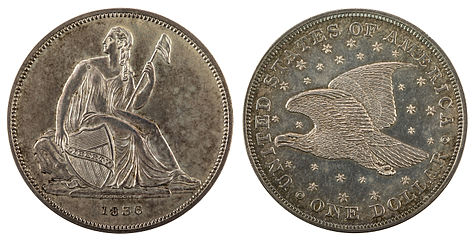United States of America | |
| Value | 1 U.S. dollar |
|---|---|
| Mass | 26.73–26.92 g |
| Edge | Reeded |
| Composition | |
| Years of minting | 1836–1839 |
| Obverse | |
| Design | Seated Liberty |
| Designer | Christian Gobrecht (based on a sketch by Thomas Sully) |
| Design date | 1836 |
| Design | Seated Liberty |
| Designer | Christian Gobrecht |
| Design date | 1838 |
| Reverse | |
| Design | Soaring bald eagle |
| Designer | Christian Gobrecht (based on a sketch by Titian Peale) |
| Design date | 1836 |
| Design | Soaring bald eagle |
| Designer | Christian Gobrecht |
| Design date | 1838 |
The Gobrecht dollar, minted from 1836 to 1839, was the first silver dollar struck for circulation by the United States Mint after production of that denomination had been halted in 1806 (the last previous silver dollars were struck in 1804 but dated 1803). The coin was struck in small numbers to determine whether the reintroduced silver dollar would be well received by the public.
In 1835, Director of the United States Mint Samuel Moore resigned his post, and Robert M. Patterson assumed the position. Shortly after, Patterson began an attempt to redesign the nation's coinage. After Mint Chief Engraver William Kneass suffered a stroke later that year, Christian Gobrecht was hired as an engraver. On August 1, Patterson wrote a letter to Philadelphia artist Thomas Sully laying out his plans for the dollar coin. He also asked Titian Peale to create a design for the coin. Sully created an obverse design depicting a seated representation of Liberty and Peale a reverse depicting a soaring bald eagle, which were adapted into coin designs by Gobrecht. After the designs were created and trials struck, production of the working dies began in September 1836.
After a small quantity was struck for circulation, the Mint received complaints regarding the prominent placement of Gobrecht's name on the dollar, and the design was modified to place his name in a less conspicuous position. In January 1837, the legal standard for the percentage of precious metal in silver coins was changed from 89.2% to 90%, and the Gobrecht dollars struck afterwards reflect this change. In total, 1,900 Gobrecht dollars were struck during the official production run. Production of the Seated Liberty dollar, which utilized the same obverse design as the Gobrecht dollar, began in 1840. In the 1850s, Mint officials controversially re-struck the coins without authorization.

